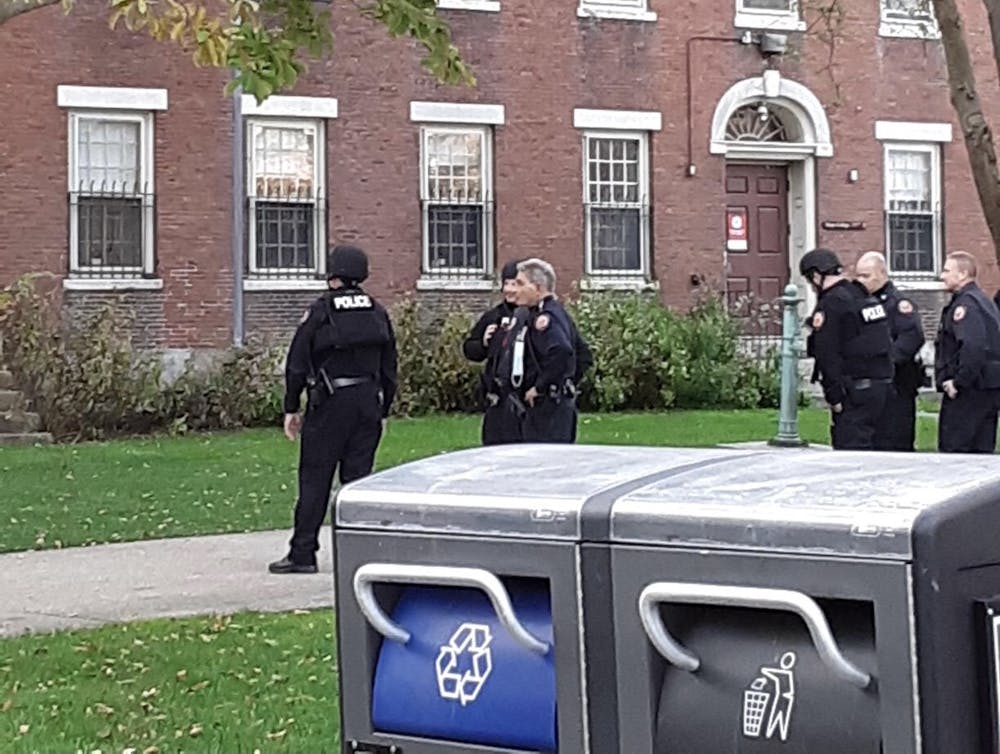Updated at Nov. 8, 1:59 a.m.
Multiple campus buildings were evacuated due to a bomb threat Sunday afternoon. Cornell, Columbia and Brown received bomb threats Sunday, while Yale University received a similar threat Friday, according to The Yale Daily News.
All buildings evacuated for the bomb threat have been cleared, according to a University alert sent to students at 5:45 p.m.
At 6:10 p.m., the University announced that a concurrent suspicious package incident had been resolved in another alert sent to students. “The suspicious package incident has been cleared,” it read. “No suspicious packages were found. Thank you for your cooperation.”
“Officers found no evidence of a credible threat,” University Spokesperson Brian Clark wrote in an email to The Herald. “Buildings that had been evacuated are now reopened, and University operations have resumed as normal.”
Brown and Providence police were responding to “an anonymous phone call of a bomb threat,” wrote Tom Verdi, deputy chief of the Providence Police Department, in an email to The Herald.
Students in Hope College were evacuated beginning around 3 p.m. Hope residents heard a fire alarm and, upon exiting, were told by University police officers to stand away from the building. Other Main Green buildings were evacuated shortly after Hope College, and the Rockefeller Library was evacuated roughly 45 minutes later.
At 3:50 p.m., Brown’s automated security alert system sent all students a message that read, “Brown and Providence Police are investigating multiple buildings on campus involving a bomb threat. All Main Green buildings, Rock/Hay, List, Lyman.”
Another alert, sent at 3:57 p.m., read, “The Department of Public Safety and the Providence Police are investigating a suspicious package on Meeting Street near the Life Sciences Building.” That was followed by an alert sent at 4:47 p.m. that stated, “The Life Sciences Building and Meeting Street area are not involved in this incident. These buildings will not be evacuated.” However, a follow-up alert sent at 4:49 p.m. advised students to avoid the Rock, the Hay, List Art Center and the buildings around the Main Green.
Campus Police Officer John Carchia, who was standing in front of Sayles Hall, said officers had been instructed to ensure that no students were in buildings on the Main Green but did not receive further information. Other police officers on the Main Green and outside the Rockefeller Library declined to comment, as did a member of the bomb squad from the state fire marshal’s office.
Vice President of Campus Life Eric Estes arrived at Hope College after being contacted by Rodney Chatman, vice president for campus safety. Because Hope is a residential building, Estes said he wanted to “show up and be supportive of students.” He added that, to his knowledge at the time, no other residential buildings had to be evacuated.
Hope College students were allowed back into the building at 4:25 p.m., according to Hope College resident Heidi Schaefer ’24.
According to The Boston Globe, “the FBI and Bureau of Alcohol, Tobacco, Firearms and Explosives may be involved in an investigation connecting the incidents at each of the Ivy League campuses over the weekend.” The University did not coordinate directly with any federal agencies during the investigation, Clark wrote, but would work with them “cooperatively” on any investigations into connections between the incidents on different campuses.
At Columbia, threats posted on Twitter by a later-suspended account, as reported by the Columbia Daily Spectator, claimed that bombs had been planted and that the author of the tweet along with others were armed with automatic weapons and would shoot police officers. Columbia officials evacuated three buildings around 2:30 p.m. for just over two hours until the New York Police Department deemed the threats “not credible.”
The New Haven Police Dispatch informed Yale about a threat from someone who claimed to have placed 40 bombs across campus, according to The Yale Daily News. The Yale Police Department found the threat to not be credible.
At Cornell, officials evacuated four campus buildings in response to bomb threats Sunday afternoon. After more than five hours, law enforcement cleared the threats.
Students who were in Hope College and the Rock at the time of the evacuation expressed shock and worry.
Hope College resident Champ Turner ’24 was initially unaware of the severity of the situation. “I thought it was the fire alarm. I just got my jacket, phone (and) wallet. I did not get my backpack (because) I thought I’d be going back in pretty soon,” he said. “Then I saw a SWAT team and realized something was going on.”
Jon Zhang ’24 and Pedro Camacho-Leon ’23 were preparing for a tutoring session on the fourth floor of the Rock when the building was evacuated. “All of a sudden the alarm started blaring. Sometimes it just goes off in the library when I come here super late at night,” Zhang said. “Then I got the text on my phone. I was like, ‘Oh sh*t, this is actually something serious.’”
The process of leaving the library was chaotic, according to Zhang. “There was this huge shuffle of people (going) down the stairs to the ground floor,” he said.
Camacho-Leon was aware of the threats other institutions had received over the previous few days. When Brown received a similar threat, “it was sadly not very surprising,” he said.
Megan Donohue ’22, a community assistant for Hope College, said she had noticed officers outside the building before the alarm went off. Because it was cold, she said students dispersed across campus.
The extent to which students were affected by the bomb threat differed, but both Zhang and Schaefer see the value of increased caution. “I personally still feel safe (on campus), but maybe (I’ll) just be a little bit more careful,” Zhang said.
Despite receiving clearance to reenter the building, Schaefer remained apprehensive about the situation. “I don’t really want to be in Hope for now in case they missed something,” she said. “How do they know for sure? Especially with all those buildings, it does make me a bit nervous.”

Peter Swope was the senior editor of digital engagement for The Brown Daily Herald's 133rd Editorial Board. He previously served as a Sports section editor and has also written stories for University News. Peter is a senior from New Jersey studying history.





